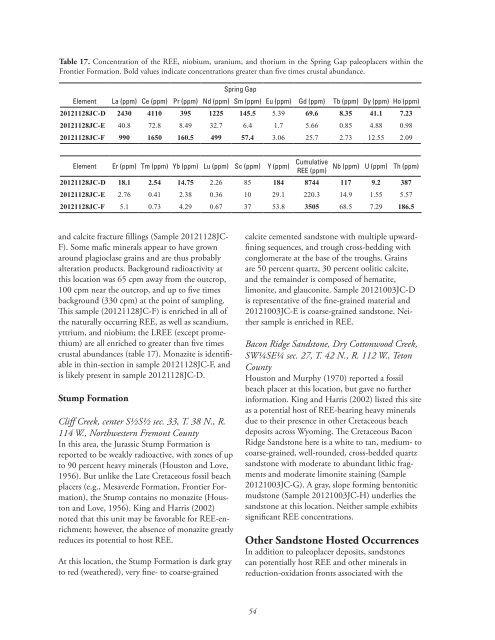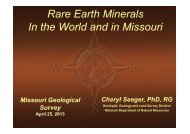You also want an ePaper? Increase the reach of your titles
YUMPU automatically turns print PDFs into web optimized ePapers that Google loves.
table 17. Concentration of the REE, niobium, uranium, and thorium <strong>in</strong> the Spr<strong>in</strong>g Gap paleoplacers with<strong>in</strong> the<br />
Frontier Formation. Bold values <strong>in</strong>dicate concentrations greater than five times crustal abundance.<br />
Element La (ppm) Ce (ppm) Pr (ppm)<br />
Spr<strong>in</strong>g Gap<br />
Nd (ppm) Sm (ppm) Eu (ppm) Gd (ppm) Tb (ppm) Dy (ppm) Ho (ppm)<br />
20121128JC-D 2430 4110 395 1225 145.5 5.39 69.6 8.35 41.1 7.23<br />
20121128JC-E 40.8 72.8 8.49 32.7 6.4 1.7 5.66 0.85 4.88 0.98<br />
20121128JC-F 990 1650 160.5 499 57.4 3.06 25.7 2.73 12.55 2.09<br />
Element Er (ppm) Tm (ppm) Yb (ppm) Lu (ppm) Sc (ppm) Y (ppm) Cumulative<br />
Nb (ppm)<br />
REE (ppm)<br />
U (ppm) Th (ppm)<br />
20121128JC-D 18.1 2.54 14.75 2.26 85 184 8744 117 9.2 387<br />
20121128JC-E 2.76 0.41 2.38 0.36 10 29.1 220.3 14.9 1.55 5.57<br />
20121128JC-F 5.1 0.73 4.29 0.67 37 53.8 3505 68.5 7.29 186.5<br />
and calcite fracture fill<strong>in</strong>gs (Sample 20121128JC-<br />
F). Some mafic m<strong>in</strong>erals appear to have grown<br />
around plagioclase gra<strong>in</strong>s and are thus probably<br />
alteration products. Background radioactivity at<br />
this location was 65 cpm away from the outcrop,<br />
100 cpm near the outcrop, and up to five times<br />
background (330 cpm) at the po<strong>in</strong>t of sampl<strong>in</strong>g.<br />
This sample (20121128JC-F) is enriched <strong>in</strong> all of<br />
the naturally occurr<strong>in</strong>g REE, as well as scandium,<br />
yttrium, and niobium; the LREE (except promethium)<br />
are all enriched to greater than five times<br />
crustal abundances (table 17). Monazite is identifiable<br />
<strong>in</strong> th<strong>in</strong>-section <strong>in</strong> sample 20121128JC-F, and<br />
is likely present <strong>in</strong> sample 20121128JC-D.<br />
stump formation<br />
Cliff Creek, center S½S½ sec. 33, T. 38 N., R.<br />
114 W., Northwestern Fremont County<br />
In this area, the Jurassic Stump Formation is<br />
reported to be weakly radioactive, with zones of up<br />
to 90 percent heavy m<strong>in</strong>erals (Houston and Love,<br />
1956). But unlike the Late Cretaceous fossil beach<br />
placers (e.g., Mesaverde Formation, Frontier Formation),<br />
the Stump conta<strong>in</strong>s no monazite (Houston<br />
and Love, 1956). K<strong>in</strong>g and Harris (2002)<br />
noted that this unit may be favorable for REE-enrichment;<br />
however, the absence of monazite greatly<br />
reduces its potential to host REE.<br />
At this location, the Stump Formation is dark gray<br />
to red (weathered), very f<strong>in</strong>e- to coarse-gra<strong>in</strong>ed<br />
calcite cemented sandstone with multiple upwardf<strong>in</strong><strong>in</strong>g<br />
sequences, and trough cross-bedd<strong>in</strong>g with<br />
conglomerate at the base of the troughs. Gra<strong>in</strong>s<br />
are 50 percent quartz, 30 percent oolitic calcite,<br />
and the rema<strong>in</strong>der is composed of hematite,<br />
limonite, and glauconite. Sample 20121003JC-D<br />
is representative of the f<strong>in</strong>e-gra<strong>in</strong>ed material and<br />
20121003JC-E is coarse-gra<strong>in</strong>ed sandstone. Neither<br />
sample is enriched <strong>in</strong> REE.<br />
Bacon Ridge Sandstone, Dry Cottonwood Creek,<br />
SW¼SE¼ sec. 27, T. 42 N., R. 112 W., Teton<br />
County<br />
Houston and Murphy (1970) reported a fossil<br />
beach placer at this location, but gave no further<br />
<strong>in</strong>formation. K<strong>in</strong>g and Harris (2002) listed this site<br />
as a potential host of REE-bear<strong>in</strong>g heavy m<strong>in</strong>erals<br />
due to their presence <strong>in</strong> other Cretaceous beach<br />
deposits across Wyom<strong>in</strong>g. The Cretaceous Bacon<br />
Ridge Sandstone here is a white to tan, medium- to<br />
coarse-gra<strong>in</strong>ed, well-rounded, cross-bedded quartz<br />
sandstone with moderate to abundant lithic fragments<br />
and moderate limonite sta<strong>in</strong><strong>in</strong>g (Sample<br />
20121003JC-G). A gray, slope form<strong>in</strong>g bentonitic<br />
mudstone (Sample 20121003JC-H) underlies the<br />
sandstone at this location. Neither sample exhibits<br />
significant REE concentrations.<br />
other sandstone Hosted occurrences<br />
In addition to paleoplacer deposits, sandstones<br />
can potentially host REE and other m<strong>in</strong>erals <strong>in</strong><br />
reduction-oxidation fronts associated with the<br />
54



